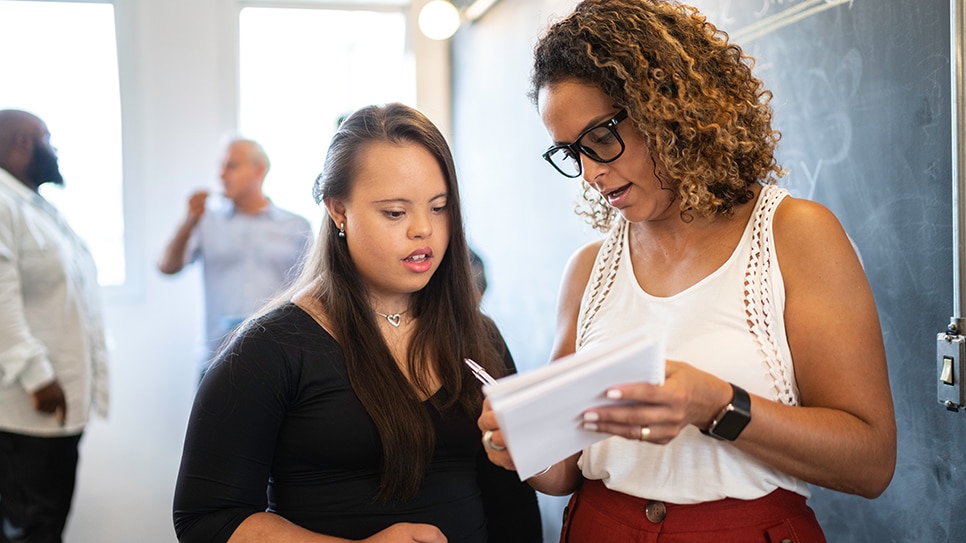
How HR leaders can navigate inclusion training with confidence
Inclusive Workplaces


Sponsored by the US Department of Labor, National Disability Employment Awareness Month occurs each October to call attention to the benefits of hiring people with disabilities. This year’s theme of “Disability: Part of the Equity Equation” highlights how disabled individuals can strengthen workforce diversity and culture. According to the Centers for Disease Control and Prevention […]

Sponsored by the US Department of Labor, National Disability Employment Awareness Month occurs each October to call attention to the benefits of hiring people with disabilities. This year’s theme of “Disability: Part of the Equity Equation” highlights how disabled individuals can strengthen workforce diversity and culture.
According to the Centers for Disease Control and Prevention (CDC), one in four US adults has some type of disability, defined as an impairment of the body or mind that makes it more difficult for the person to do certain activities and interact with the world around them. This includes visible disabilities, such as someone using a wheelchair or wearing a hearing device, as well as invisible disabilities like autism, depression, diabetes, ADHD and dyslexia.
Raising employee and manager awareness of the disabled community, and how to prevent unconscious bias, microaggressions, discrimination and physical barriers from becoming obstacles to employment, promotion and productivity, can help organizations embrace employees with disabilities into their workforce.
4 Reasons Why Organizations Should Hire People With Disabilities
1. People with disabilities represent an untapped labor pool
Finding the right talent can be difficult, and if your organization isn’t hiring people with disabilities, you’re missing out on a largely untapped talent pool. Over 67 million American adults with disabilities are looking for an opportunity to work and represent a huge source of innovation and productivity for companies.
Rather than focusing on a job candidate’s disability, a healthier, more positive approach to hiring is to view the whole person, evaluate how they can contribute to your organization and its culture and recognize that the potential employee may have different needs.
2. Hiring employees with disabilities promotes workplace diversity
According to the World Economic Forum, 90% of companies have prioritized diversity, equity and inclusion (DEI) as a top business objective. Considering disability in DEI initiatives can help increase the diverse makeup of a workforce and convey a clear message to candidates and employees that the organization cares about them and values their skills and abilities.
Hiring people with disabilities also communicates social responsibility and demonstrates that a company is interested in broader social issues impacting the community and the people in it.
3. It’s illegal to discriminate against individuals for any reason
Some employees and managers may have never worked with someone with disabilities, and are unaware of the workplace rights and discrimination protections that people with disabilities have under the Americans With Disabilities Act (ADA). Failure to comply with this law can result in significant fines, fees, penalties and reputational damage.
Providing ongoing education, training and communication are important to ensuring ADA compliance, preventing disability discrimination claims and setting the proper tone and groundwork for how employees and managers should perceive the disabled community.
4. Providing reasonable accommodations doesn’t have to be expensive
Under the ADA, people with disabilities are entitled to reasonable accommodations, defined as a modification or adjustment to a job or work environment that enables a qualified person with a disability to participate in the application process or perform essential job functions. Employers are required to provide reasonable accommodations to qualified individuals unless it would impose a significant expense or disrupt operations of the business.
Employers may perceive that reasonable accommodations for workers will be expensive. However, a US Department of Labor survey found that a majority of employees with disabilities do not require accommodation to do their job, and for the ones who do, the typical costs were minimal at $500 or less.
Traliant Insight
National Disability Employment Awareness Month is a reminder of the important roles that people with disabilities can fill when employers remove barriers to their success. Raising disability awareness through ongoing education, training and communication can help organizations build a diverse, adaptive and resourceful workforce that is inclusive of individuals with disabilities.